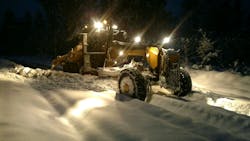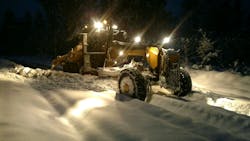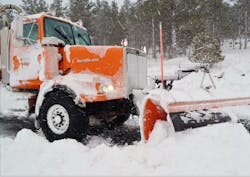By: Marc Della Rocca
It’s a dry heat.
So goes the unofficial mantra for all things weather in Arizona. To the unacquainted, the Grand Canyon State is an endless season of 100°+ days and 75° nights with nary a snowflake in sight. Winters are the stuff of warm vacation dreams where sitting poolside at five-star Scottsdale resorts or rooting for favorite teams at spring training baseball games is about as intense as it gets.
In Coconino County, however, winter is a little bit different. Located less than 150 miles north of Phoenix, Coconino County is considered the fifth-snowiest location in America, averaging 110 in. of snow per year.
With high-precipitation snow seasons that routinely run from November through April, snow response presents some unique challenges to the team of the Coconino County Public Works Department (CCPW). First of these is size: Coconino County is the second-largest county in the continental U.S., encompassing almost 19,000 sq miles. Within it, the CCPW team is responsible for maintaining more than 1,000 miles of gravel and paved county roads located across often isolated, heavily treed and desert terrain.
Elevation also plays a factor. Ranging between 4,000 to 8,000 ft above sea level, Coconino County routinely throws extremely low winter temperatures at equipment and operators, which can hinder the performance of both. There also are the freeze-thaw cycles—the nation’s most severe—where snow melting and refreezing wreaks havoc on asphalt.
The county has dynamic equipment in its snow-fighting arsenal, including this motor grader, which makes quick work of a white road.
“Right Place, Right Time”
To meet these challenges, CCPW developed its snow plan as a cost-effective protocol to maximize the department’s limited snow-removal resources through strategic, scalable deployment to areas most impacted by snowfall. Appropriately dubbed “Right Place, Right Time,” this plan works through a storm-by-storm consideration of weather, seasons and the locations of actual, plowable amounts of snow. The goal of “Right Place, Right Time” is to plow all county roads, while maintaining a safe environment for CCPW operators and the traveling public.
In 2001, CCPW became the nation’s first public works agency to be accredited by the American Public Works Association (APWA). During its reaccreditation in 2017, APWA recognized CCPW’s snow plan with two “Best Practice” acknowledgements for snow operations preparation and response. The plan relies on four key elements: preparation, mobilization, response and after-storm operations.
Preparation
Preparation is the Coconino County snow plan’s most comprehensive and labor-intensive pre-season activity, especially where equipment is concerned. The CCPW team has about 50 pieces of snow-removal equipment (plow trucks for paved roads and graders for gravel roads) to get ready for when the white stuff starts falling. Preparation usually begins in early July with field inspections and repairs to later transition this equipment from road maintenance to snow-removal duty. Pre-season prep work also includes installing safety equipment such as snow-friendly lighting and filling out inventories of such items as plow-cutting edges, which must be ordered from Canada. Once the equipment is ready to go, it is staged at about 10 locations around the county.
Prepping the CCPW team is equally important. Late summer and fall are highlighted by winter gear checks and safety meetings to build awareness of hypothermia and the importance of using the buddy system in the field. Dispatchers are brought up to speed so that they can coordinate with the public and first responders during emergency situations. Contract operators also are secured during the summer and fall months to assist CCPW in the event of large snow events.
Snow-removal operations in Coconino County is a community effort. As such, prepping stakeholders plays an integral role in CCPW’s winter preparedness. Each fall the team develops a communication protocol to make sure everyone from state troopers to school district bus drivers are on the same page for the upcoming snow season. This protocol includes CCPW’s winter storm road-closure plan, which identifies closure areas, and features road closure and reopening press releases for the media.
Mobilization
“Right Place, Right Time” begins with the snow plan’s mobilization component, which also earned APWA “Best Practice” accolades last year. Mobilization relies on readiness. On any given day between November and April, the whole CCPW team—management, operators, dispatchers, mechanics, public information members—maintain operational readiness to mobilize for whatever Mother Nature might have in store. To determine just what that might be, the team keeps in regular contact with the National Weather Service (NWS) in Flagstaff, sometimes as early as a week before a forecasted storm.
Snowstorm tracking, or Storm Watch, is the linchpin activity of CCPW’s mobilization efforts. When a storm is looming, CCPW’s snow shift supervisors are tasked with around-the-clock monitoring of weather radar and NWS forecasts to determine when a snowstorm will go from prediction to production and, in turn, initiate the department’s response mode.
Response
In Coconino County, effective winter storm response is wholly contingent upon CCPW’s ability to direct resources where (and when) they are needed most. Response mode is a continuation of the scalable “Right Place, Right Time” protocol, which allows the team to strategically deploy response assets. Because snowstorm conditions can differ dramatically around the county, CCPW transitions from mobilization to response based primarily on Storm Watch information.
Snowstorm response is a tiered system that relies on several phases:
Snow Patrol: Snow Patrol is normally implemented when the NWS predicts a 20% or greater chance of snow entering south-central Coconino County by 3 p.m. on a given day. By providing information from the field, Snow Patrol trucks are the “eyes and ears” that determine CCPW’s next response steps before a storm arrives.
Base Crews: Base Crew deployment occurs between when snowfall begins and accumulation has reached 2-4 in. Base Crews, which range from six to 14 operators, are deployed either through NWS forecast data or through Snow Patrol observations, and are charged primarily with clearing the county’s main arterial and collector roads.
Full Crews: Base Crews will transition to Full Crews when storms intensify and accumulations of more than 4 in. of snow are forecasted. For large storms, a full crew deployment can total up to 50 operators and senior operators working in equal contingents over 12-hour shifts to keep all county-maintained roads open and passable. In order of priority, CCPW’s “A” and “B” shifts focus on paved arterial, collector and high-density local roads, which includes ice-control treatments on hills and intersections. “C” shift focuses on unpaved surfaces, cul-de-sacs and short dead-end roads. For safety, contract operators will be brought in as needed to relieve weary crews.
CCPW’s Mechanical Services Division also is a vital part of this team. When conditions are at their worst, up to a dozen heavy mechanic specialists are at their best keeping the department’s graders and plow trucks in the field.
After-storm operations
Snow storms have a life cycle, and the snow plan helps the CCPW team to respond as efficiently as possible through each stage of it. The final stage, after-storm operations, can be among the most challenging. As crews work on cutting ice, knocking down snow drifts and fixing freeze-thaw potholes, they also can be called upon to reopen sections of roads that needed to be closed in the interest of public safety. Crews also must contend with roads filling up with vehicles that are returning from a brief blizzard hiatus to an unfamiliar and often icy winter environment. Seasonal factors also play a large part in after-storm operations; snowstorms during the dark, cold days of winter often require more after-storm work than their spring counterparts, when longer, warmer days help to melt snow and dry things out.
Coconino County’s response teams can have up to 50 operators on hand for 12-hour shifts throughout the course of a snow event.
Communication is key
An “all-hands-on-deck” snowstorm has a lot of moving parts. Not surprisingly, good communication is crucial to successful and safe snow-response operations. During snowstorms, CCPW dispatchers work to address community concerns; road maintenance district supervisors coordinate with snow shift supervisors who monitor field crew activity to gauge how the work is going and make sure the crews are safe, all the while keeping an eye on the weather. This system keeps everyone informed about what is happening and where resource deployment needs to be ramped up or scaled back. In addition, the snow plan’s “Snow Director Schedule” component allows a rotational CCPW snow director to share information with emergency management, public information officers and county leadership on response activities, accidents and emergencies.
Coconino County is a land of vast beauty where winter weather can be as diverse as the scenery. The men and women of Coconino County Public Works are dedicated to the year-round maintenance of these roads, especially during the challenging months of snow season.
About The Author: Della Rocca is community relations manager for Coconino County Public Works.



